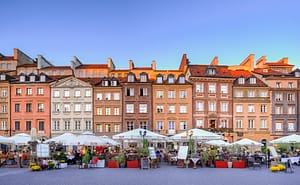Palace of Culture and Science
Constructed in 1955, the Palace of Culture and Science divides Warsaw’s inhabitants into those who still hate it and those who learned how to live in its presence. This ‘gift of the Soviet people to the Polish nation’, offered by Joseph Stalin himself, has become one of the city’s most widely recognised symbols. The Palace houses a cinema, a swimming pool, four museums, four theaters, four universities and numerous coffee stores and bars. Visitors can also take advantage of the terrace located on the 30th floor, offering a mesmerising view of the city’s panorama.
Old Town
Included on the UNESCO World Heritage list, Warsaw’s Old Town was completely rebuilt after World War II, based mostly on 18th century paintings by the Italian painter Canaletto. The heart of the area, guarded proudly by the Warsaw mermaid, is the Old Town Market Place with its restaurants and cafés. Visitors should also make sure to see the Barbican and St. John’s Cathedral, as well as explore the picturesque winding streets.
Royal Castle
Formerly the royal residence between the 16th and 18th centuries, the castle currently houses a museum and is open to the public. Restored and furnished with repossessed furniture and works of art, it transports visitors to the time of Stanisław August Poniatowski, the last kind of Poland.
Fotoplastikon Warszawski
Built in the early 20th century, the Warsaw Fotoplastikon in the only such institution in Poland and one of the few in the world. The stereoscopic theatre based on the Kaiserpanorama system of rotating images, allowed viewers to watch changing three-dimensional images and was a precursor for cinemas. Warsaw Fotoplastikon’s archive include over 3,000 original photographs from the city and around the world.
Muranów
Built right after the war on the rubble from the completely destroyed Jewish ghetto, Muranów was designed as part memorial, part housing estate, part representation of the ideology of socialist realism. Walking around the neighbourhood, visitors can see and feel the city’s history, outside of pristine museum walls.
Keret House
Described as ‘an art installation in the form of an insert between two existing buildings, representing different historical periods in Warsaw’s history’, Keret House is the narrowest, fully-functional house in the world. Designed by Jakub Szczęsny and operated by the Polish Modern Art Foundation, Keret House is used primarily as a space for art residencies, however visitors are invited once a month. Those interested should book their tour in advance.
Copernicus Science Centre
Located on the bank of Vistula River, Copernicus Science Centre is the largest science centre in Poland, with over 450 interactive exhibitions in six interdisciplinary galleries. Especially worth visiting is The Heavens of Copernicus planetarium which offers movie screenings and live shows. Those who want to escape the crowds of excited children can choose to visit the centre during adults-only evenings taking place once a month between 7pm and 10pm.
Vistula River
Those visiting the city during the spring and summer months cannot leave without heading to the river bank. Especially popular among young people, at the weekend both sides of the river become a popular meeting spot. The east side, with its sand and grass, is characterised by a more natural feel and countless campfires, whereas the west side, covered in concrete attracts people with numerous food trucks and beach bars.
Koneser Vodka Distillery
Currently the centre of the vibrant entrepreneurial scene and home to Google Campus, Koneser Vodka Distillery is an interesting example of Gothic style industrial architecture. Relatively undamaged during the World War II, the old distillery as well as the surrounding neighbourhood give a good glimpse of what the city used to look like before the war.
Powązki Cemetery
The resting place of some of the most important names in the country’s history, Powązki Cemetery is a real treasure, with impressive sculptures from the neo-classic period and Secession to contemporary art. Established in 1790 by King Stanisław August Poniatowski, the cemetery’s catacombs house the remains of King’s family and members of his court. In 1925, the Avenue of Merit (Aleja Zasłużonych), located along the southern wall of the catacombs, became a resting place for accomplished Poles, including Noble Prize-winning writer Władysław Reymond and writer Maria Dąbrowska.

